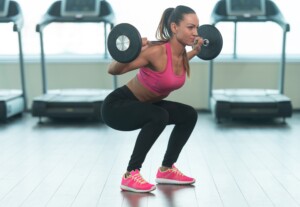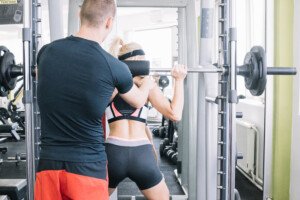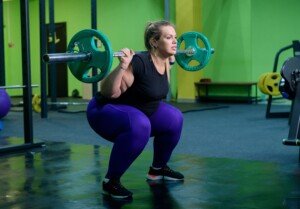
Fear of the barbell squat can affect men as well as women.
When I was a personal trainer at a gym, I had clients who were “afraid” to barbell squat, though “fear” isn’t exactly the right word to use; it’s not as though the weight might bite back.
However, some women (and men) just don’t want to get under a weight or have a weight across their back.
There are very easy ways to get past your fear of squatting with a barbell.
There are two kinds of barbell squats: Smith machine (or tracked barbell) and free barbell.

The Smith machine. Freepik.com
Some people who are nervous about the free version may not even realize that a tracked version exists.
These would be novices who have not spent much time in a gym, or if they have, have not ventured anywhere near the tracked device to know it exists.
However, even the tracked device can be “intimidating” to beginners who have never squatted with a barbell.
To overcome being afraid to barbell squat, simply get your legs conditioned by doing body weight squats.
Stand before a mirror and get going. This will strengthen your abilities. Go for 20 repetitions. Practice good form, even though you’re only using body weight.
Good Form
Both feet are flat on the floor at all times; feet are about shoulder width apart, though wider is okay; feet are aligned; feet are pointed straight ahead or slightly outward, though experienced people may turn their feet even more outward to target inner thighs.
The lower back is arched; chest is “puffed out” or “big.” You’re looking straight ahead or slightly upward.
Don’t go beyond thighs parallel to the floor, though more advanced folks sometimes do this.
When straightening up from the squat, don’t lock out the knees but instead, keep them “soft” or just a hair less than straight.
Once you have solid form down, the barbell squat will be less intimidating, especially as your legs get stronger from the body weight version.

Good form. Shutterstock/Reshetnikov_art
Once you get comfortable with the body weight version, hold dumbbells in each hand, arms straight at sides, and go again.
You can also place feet on air cushions to create instability while performing the exercise.
This will force your body to adapt and become more efficient with squatting motions. You can also do the exercise atop the round portion of a BOSU board.
Another way to overcome fear of the barbell squat is to place the gym’s lightest barbell across your upper back. Never place the weight across your neck, never.
The lightest barbell may be 20 pounds; this is very light for a squat. Place the weight on the floor and have a seat before it.
Pick it up and raise it above your head, then settle it behind yourself, on your upper back. Then stand and begin squatting.
You can stand over the seat and perform the repetitions with the seat under you if you’re still a bit afraid or nervous, or, you can step away from the seat and do the exercise without the seat under you.
You are now doing free barbell squats, though with a very light weight. As you become more at ease, use a heavier weight. Work up from that point.
Pre-weighted barbells are a lot shorter than the Olympic barbells, and are thus less “intimidating.”
When using an Olympic barbell (unloaded it weighs 45 pounds), use a squat rack always.
The rack has features that prevent you from falling all the way to the floor with the barbell should your legs give out.
To diminish that “afraid” feeling, have an experienced person stand behind you while you perform barbell squats.
You can also use the Smith machine or tracked device, which eliminates some of the balance required of free barbell squats.
Squatting apparatus is universally placed before mirrors so that you can check your form.
Make sure you are evenly under the weight, rather than more to one side than the other.
Hire a personal trainer to assist with your fear of barbell squats. Don’t rely on watching other people doing the exercise because their form might be wrong, even if they are big bruisers or have enviable legs.
If you’re short on money, realize that you can hire a personal trainer for just one or two sessions; doesn’t have to be a full training package.
 Lorra Garrick is a former personal trainer certified through the American Council on Exercise. At Bally Total Fitness she trained women and men of all ages for fat loss, muscle building, fitness and improved health.
Lorra Garrick is a former personal trainer certified through the American Council on Exercise. At Bally Total Fitness she trained women and men of all ages for fat loss, muscle building, fitness and improved health.
.
























